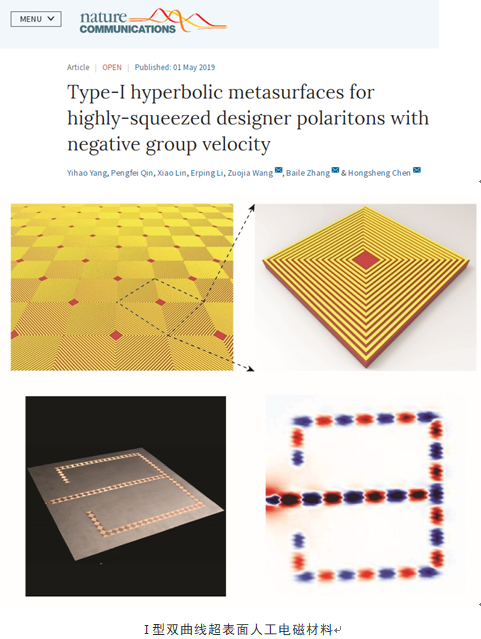The research paper on new hyperbolic super-surface artificial electromagnetic materials Type-I hyperbolic metasurfaces for highly-squeezed designer polaritons with negative group velocity was published online on May 1, 2019 in the international comprehensive journal Nature Communications.Dr. Yang Yihao from Zhejiang University, School of Information and Electronics (Instructor: Prof. Chen Hongsheng) and Ph.D. student Qin Pengfei (Instructor: Professor Li Erping; Co-instructor: Prof. Chen Hongsheng) is the co-first author.

Satellite communications, radar, sensing systems and other electronic devices and photonic devices that are closely related to our lives are inseparable from the interaction between electromagnetic fields and matter. Studying the regulation of electromagnetic fields by new electromagnetic materials has always been an important research topic in electromagnetics and optics. In recent years, scientists have discovered that there are special hyperbolic polaritons in the van der Waals material and the artificial electromagnetic metamaterials heterojunction. It provides a new regulation mechanism for the interaction of light and matter at the nanometer scale. Taking the hyperbolic material boron nitride as an example, the scientists found that in the mid-infrared band, the two different energy bands of the material support hyperbolic polaritons. Boron nitride materials have many outstanding advantages, including extremely strong constraints on light, extremely high equivalent refractive index and low transmission loss, and are expected to be applied in the fields of superlens, enhanced light-substance interaction, and strong Planck thermal radiation. However, in natural materials, hyperbolic polariton can only exist in the narrow infrared frequency band, and the hyperbolic electromagnetic material with design frequency and dispersion control has important research and application value.
In this work, the research team proposed a new type of artificial electromagnetic material, the type I hyperbolic supersurface, whose magnetic permeability is positive in the plane and negative in the out-of-plane direction.The supersurface supports a special designer polaritons whose relative wavevector is extremely large (so the equivalent refractive index is extremely high) and the group velocity is negative.In the experiment, the supersurface was formed by arranging metal coils and implemented using printed circuit board technology.The researchers further characterized the supersurface and measured its equivalent relative refractive index up to 60. The group velocity of the supported surface waves was as low as 1/400 of the vacuum speed.In addition, because the surface wave group velocity is negative, the researchers experimentally observed that the super-surface dispersion curve is a cone, that is, the higher the frequency, the longer the wavelength.Through the tailoring of the super-surface, the research team produced a microwave waveguide circuit that is only a few times the size of a conventional waveguide circuit due to the extremely high refractive index of the super-surface.
This work provides a new idea for the study of hyperbolic artificial electromagnetic materials and provides a new research platform for polariton photonics.In the field of applied research, the hyperbolic supersurface is expected to be applied to ultra-compact waveguide circuits, slow-light devices, wireless energy transmission, and low-threshold terahertz free electron lasers.
In this work, Dr. Lin Xiao, a postdoctoral fellow at Nanyang Technological University, also made important contributions.The work was funded by the National Natural Science Foundation of China Outstanding Youth Fund Project and the Surface Fund Project.
